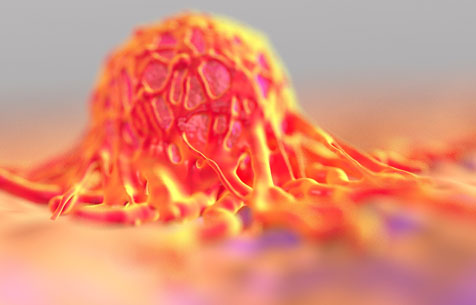


Discover our rat cancer models in preclinical oncology
Why using rat models is important in the drug discovery process?
The laboratory rat is one of the most commonly used experimental animals. It offers a number of advantages for modelling human diseases, developing new therapeutics agents, and in studying response to environmental agents. Remarkable progress in understanding cancer susceptibility, mecanisms and therapeutics has been made using rat models.
Rats represent valuable tools for better characterization and optimization of your compounds in human clinical trial initiation.
Morphological characteristics of rat cancer models
Rat cancer models are better mimic of the human pathology. For example, the tumor stroma component is generally 1.5 to 2-fold higher in rat than in mouse cancer models. Human tumor in rats have approximately 2-fold greater blood/plasma content and permeability than human tumors in mice.
This characteristic can contribute to better drug and tracer tumor uptake. Rat models are highly appropriate for anti-angiogenesis, vascular targeted drug evaluation as well as stromal component (fbroblasts, cell matrix…) targeted therapy or medical device.
PK/PD, antitumor activity and imaging follow-up
What are the rat advantages for PK (pharmacokinetic) analysis ?
- Repetitive biological sampling
- Large choice of administration routes (including IV infusion)
- Hepatic metabolism differs between mice and rats with rats having drug PK profiles closer to humans.
Besides, the pharmalogical doses in rats are similar to human administered doses.
To finish, rats models offer larger body size for better in vivo localization and imaging, as well as specific uptake of PET tracers.

Oncodesign Services offers a large bank of rat cancer models
With over 25 years of experience, Oncodesign Services offers a range of discovery & preclinical services built upon a rat cancer models of syngeneic, cell-derived xenograft (CDX) and patient-derived xenograft (PDX) tumors.
Over 500 syngeneic, CDX and PDX tumor models are established in-house, covering 20 organ origins and up to 35 pathologies: bladder, blood, brain, breast, cervix, colon, head and neck, kidney, liver, lung, skin (melanoma), muscle, osteosarcoma, ovary, pancreas, prostate, Schwann cell, stomach and more. These cover solid tumors, hematological malignancies and metastasis models.
Our rat and mouse tumors are used for in vivo modeling, in vitro screening and for target expression analysis. The tumors are stored as viable frozen stocks for propagation and often in FFPE blocks for ex vivo analysis of the TME.
Browse our list of rat tumor models :
| Cancer origin | Syngeneic models | Xenogeneic models (CDX) | Xenogeneic models (PDX) |
| Colon | DHD/K12/TRb (PROb)* | Caco-2, COLO-205, HCT-116, HCT-15, HT-29, LoVo, LS 174T, RKO, SW-480, SW-620 | + 5 PDXs |
| Brain | GV1A1*, GS-9L | CGL-1, CGL-3, CGL-9, LN229, SNB-19, U-87 MG | + 8 PDXs |
| Bladder | AY-27 | RT-4 | |
| Breast | MAT-B-III, DMBA-induced | BT-474, HCC-1937, MCF-7, MDA-MB231, MDA-MB436, MDA-MB468, ZR-75-1, MX-1 | + 2 PDXs |
| Head & Neck | FAT-7 | KB, LB771-HNSCC | |
| Prostate | R3327H*, Mat-Ly-Lu* | DU-145, PC-3, PC-3-MM2 | + 1 PDX |
| Skin | A-375, A-431, C81-61, CMEL-5, KUL58-MEL, LB1319-MEL, LB1842-MEL, LB33-MEL.D, LB929-MEL, UZG4-MEL, UZG5-MEL | ||
| Lung | A-549, Calu-3, Calu-6, NCI-H146, NCI-H209, NCI-H460, NCI-H69, SK-MES-1 | + 6 PDXs | |
| Liver | Hep 3B, SK-HEP-1 | ||
| Pancreas | BxPC-3, Capan-1, MIA PaCa-2, PANC-1 | ||
| Ovary | A2780, IGROV-1, NIH:OVCAR-3, PA-1, SK-OV-3 | + 1 PDX | |
| Blood | ARH-77, KG-1a, KM-12 PE, MV4-11, U-937 | ||
| Kidney | BB64-RCC, Caki-1, LB996-RCC |
(*) BDIX and Cop Rat strains are cryopreserved
Animal well-being, our top priority
All our sites maintain the full AAALAC International accreditation of our animal care and use program. AAALAC International is a private, non-profit organization that promotes the human treatment of animals in science through voluntary accreditation and assessment programs.
Oncodesign Services is guided by the Three Rs (3Rs) principles for more ethical use of animals in testing.
1. Replacement which refers to the preferred use of alternative methods over animal methods whenever it is possible to achieve the same scientific aims. Oncodesign Services dedicates resources to developing alternatives and more predictable models. These methods include computer modeling, organoids…
2. Reduction which refers to methods that enable researchers to obtain comparable levels of information from fewer animals, or to obtain more information from the same number of animals.
3. Refinement which refers to methods that alleviate or minimize potential pain, suffering or distress, and enhance animal welfare for the animals used. These methods include non-invasive techniques as imagery techniques.



